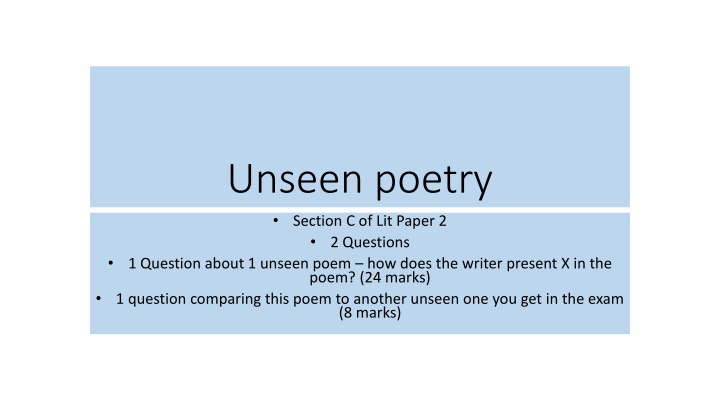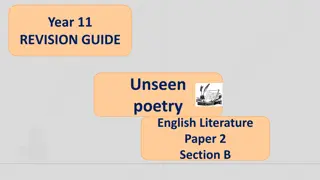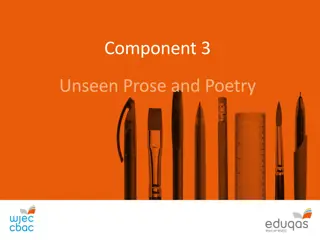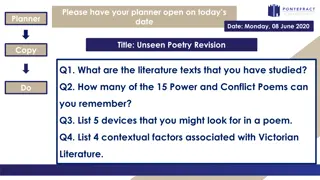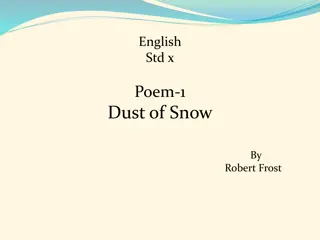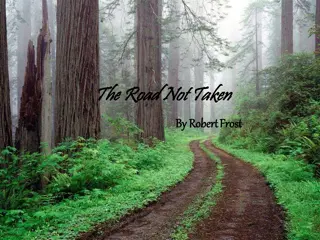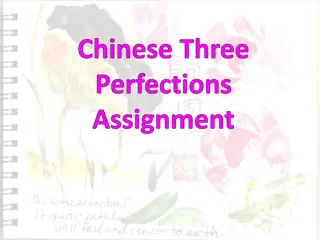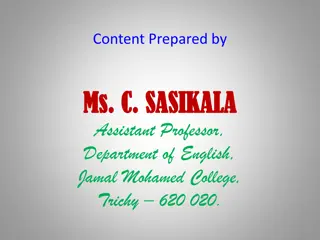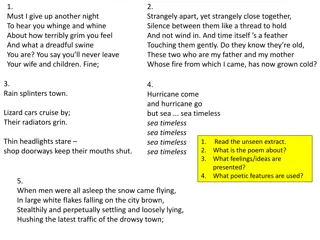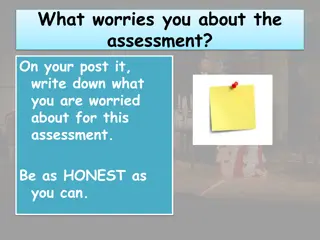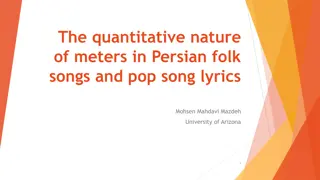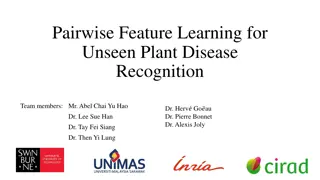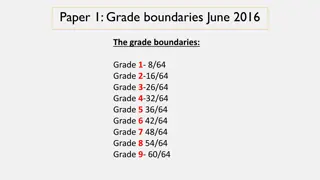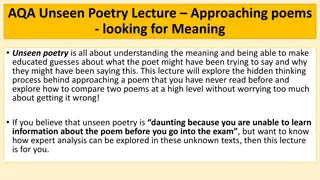Unseen Poetry Analysis: Winter Reflections in "Hard Frost" by Andrew Young
Explore the reflective nature of winter in Andrew Young's "Hard Frost" where the poet depicts the harshness and beauty of the season through vivid imagery and personification, highlighting the temporary nature of winter in the face of the impending arrival of summer. Analyze the portrayal of winter through the poet's use of language, structure, and form, delving into the contrast between the cruelty and allure of the season.
Download Presentation

Please find below an Image/Link to download the presentation.
The content on the website is provided AS IS for your information and personal use only. It may not be sold, licensed, or shared on other websites without obtaining consent from the author.If you encounter any issues during the download, it is possible that the publisher has removed the file from their server.
You are allowed to download the files provided on this website for personal or commercial use, subject to the condition that they are used lawfully. All files are the property of their respective owners.
The content on the website is provided AS IS for your information and personal use only. It may not be sold, licensed, or shared on other websites without obtaining consent from the author.
E N D
Presentation Transcript
Unseen poetry Section C of Lit Paper 2 2 Questions 1 Question about 1 unseen poem how does the writer present X in the poem? (24 marks) 1 question comparing this poem to another unseen one you get in the exam (8 marks)
Hard Frost Andrew Young In Hard Frost , how does the writer portray Winter? Frost called to the water Halt! And crusted the moist snow with sparkling salt; Brooks, their own bridges, stop, And icicles in long stalactites drop. And tench in water-holes Lurk under gluey glass like fish in bowls. In the hard-rutted lane At every footstep breaks a brittle pane, And tinkling trees ice-bound, Changed into weeping willows, sweep the ground; Dead boughs take root in ponds And ferns on windows shoot their ghostly fronds. But vainly the fierce frost Interns poor fish, ranks trees in an armed host, Hangs daggers from house-eaves And on the windows ferny ambush weaves; In the long war grown warmer The sun will strike him dead and strip his armour.
How Do I Approach the Unseen Poem? 1 2 3 Read the poem through once and highlight relevant words and phrases that stand out and that you think are interesting. Read the question first before you read the poem it will give you a clue for what to look for. Read the poem through a second time and this time LABEL techniques and features. 4 5 6 Read the poem through a third time looking for more techniques and annotate the effect of the techniques around the poem. Write down what you think the poem literally means and write a sentence which links it to the question Plan your response see next slide
LOA: Reflective poem about winter. Juxtaposes cruelty of winter against its beauty. Ultimately, winter is only a temporary state. INTRODUCTION Stanza 1 -personification of frost - seems threatening + powerful. Discuss images of the frost and ice. LANGUAGE Stanza 2 the beauty of winter is alluded to discuss image and alliteration. A semantic field of death is created why? Discuss references to challenges of winter. LANGUAGE Whole poem regular rhyme scheme and stanza length what might this suggest about inevitability of nature + the seasons? STRUCTURE/FORM Final stanza - semantic field of war introduced battle between summer and winter. Personification of the sun in the final line look at alliteration. LANGUAGE and STRUCTURE Despite the challenging conditions that winter presents, the poem reminds us that it is only a temporary state summer will win in the end. CONCLUSION
Useful Phrases: This suggests.. This may make the reader feel The poet conveys a sense of The word which is particularly effective is Perhaps the author has used this phrase to .... The use of this adjective/verb/imperative suggests.... EVIDENCE Developing your answer For example As well as In the case of Furthermore As revealed by In addition to Literally For instance Metaphorically This is well illustrated in . Linking to the Q Figuratively/Symbolically This helps portray . Here, we can see the writers portrayal of The sense of .is shown....
At the start of the poem, the writer presents winter, and specifically, the frost as a powerful threat. Even the title of the poem Hard Frost suggests an enemy that will be difficult to overcome. The adjective hard suggests something unbreakable and tough whilst it could also suggest something cold and unfeeling. In the first line, the writer personifies the frost to seem like an evil threat. Through the use of the imperative line Frost called to water Halt! the frost is made to seem challenging and strong. This image of the frost being a powerful adversary is developed on the second line through the use of the dynamic verb crushed which suggests that the frost and the winter will have no mercy on nature. The sense of winter s power and threat is clearly established in the opening stanza. Make a point about the poem that links to the question. Point Select some evidence from the poem to support your point. Evidence Explain the effect of the language in the quotation focus on MITSL. Explain Link your ideas back to the question and point you made earlier. Link
In Hard Frost, how does the writer portray Winter? Hard Frost Andrew Young Frost called to the water Halt! And crusted the moist snow with sparkling salt; Brooks, their own bridges, stop, And icicles in long stalactites drop. And tench in water-holes Lurk under gluey glass like fish in bowls. In the hard-rutted lane At every footstep breaks a brittle pane, And tinkling trees ice-bound, Changed into weeping willows, sweep the ground; Dead boughs take root in ponds And ferns on windows shoot their ghostly fronds. But vainly the fierce frost Interns poor fish, ranks trees in an armed host, Hangs daggers from house-eaves And on the windows ferny ambush weaves; In the long war grown warmer The sun will strike him dead and strip his armour.
A reflective poem about winter. Juxtaposes the cruel, challenging aspect of winter against the beauty of it. Ultimately, winter is only a temporary state. LANGUAGE Hard Frost is a deeply reflective poem about winter. Winter, in literature, is often portrayed as the cruelest of the seasons. The poet captures this traditional portrayal of winter, encapsulating its cruel aspects and juxtaposing them against the true beauty that can be found in winter. We are left with the overarching sense that we must urge ourselves to see that this, like life is only ever a temporary state and winter moves to summer.
Focus on the personification of the frost and how it is made to seem threatening and powerful. Discuss the images of the frost and ice in stanza one. LANGUAGE Across the poem, the writer explores winter s cruelty. Early on in the poem, we are presented with the line Frost called to the water Halt! . Immediately, we see Winter personified, with the use of the past tense verb called . Initially, this demonstrates that the writer is portraying a past event, but the use of called perhaps portrays winter as so powerful that it deserves to be listened to. Furthermore, the use of the imperative exclamatory Halt! adds to an abrupt sense that Winter has arrived, perhaps suggesting that Winter arrives so abruptly that you don t see it until it is too late. The writer, here, could be implying that in order to truly appreciate the world around us, we must first appreciate its beauty in Summer, before Winter so abruptly announces its presence. Furthermore, the writer s use of imagery portrays winter as a powerful force, with an ability to crust the moist snow with sparkling salt . Here, the verb crusted is a particularly interesting choice. It portrays a detailed action that it can protect something vulnerable in such a beautiful way as it is sparkling which has connotationsof diamonds, perhaps suggesting that the writer doesn t see Winter as such an entirely brutal force as that portrayed in the abrupt opening line. Alternatively, crusted could also suggest that Winter s effects, as strong as they can be, can only impact on something slightly. A crust is just the outside, and perhaps here the writer is metaphorically suggesting that while Winter changes the appearance of things, it does not change their essence.
In stanza 2 the beauty of winter is alluded to discuss the image and alliteration. A semantic field of death is also alluded to why? Discuss the references to the challenges of winter. LANGUAGE Your Go Sentence starters: As the poem progresses, we see that winter is portrayed as . The writer has used.... An example of this is..... Here, the writer could be suggesting.... The use of the word....... This suggests that winter is being portrayed as being..... Figuratively, the writer may be implying that.....
Structure of the poem regular rhyme scheme and stanza length what might this suggest about the inevitability of nature and the seasons? STRUCTURE/FORM As the poem progresses, we continue to see different ways in which Winter is portrayed. We also see another portrayal of it through the structural choices the writer makes. For example, the poem not only has a regular rhyme scheme, but it also has a regular stanza and line lengths. The rhyming couplets are perhaps demonstrating that the writer is showing Winter s inevitability. It will always come around, and we cannot avoid it coming. It could be said that the writer is portraying the relationship between humans and nature as a difficult one, one that humans will never win; we are at the mercy of the seasons.
Final stanza sees a semantic field of war introduced a battle between summer and winter. Personification of the sun in the final line look at the alliteration. LANGUAGE and STRUCTURE Your go Sentence starters: As the poem progresses, we see that winter is portrayed as . The writer has used.... An example of this is..... Here, the writer could be suggesting.... The use of the word....... This suggests that winter is being portrayed as being..... Figuratively, the writer may be implying that.....
Despite the challenging conditions that winter presents the poem reminds us that it is only a temporary state summer will win in the end. Make a comment about the title. CONCLUSION Across the poem, Winter is first portrayed as a cruel, abrupt force to be reckoned with. Although the writer portrays ideas about the beauty that Winter can bring, he also portrays it as cruel and inevitable. Humans can do nothing to fight it and we are powerless. However, the tone of the poem changes further, with the introduction of war imagery. This war imagery is used to provide humanity with more hope against Winter although we cannot fight its arrival, Summer eventually will defeat it, like a soldier defeating an army. Given the poem s title of Hard Frost , it is interesting that the frost is the very thing that the sun, Summer, can indeed destroy. With its simple presence, the sun brings warmth to humanity, one which, I would argue, we are urged to appreciate in the poem.
Things you should NEVER NEVER write! At first I didn t understand the poem but after reading it a couple of times I think The poem has no rhythm I think the poem needed to rhyme more because I like poems that rhyme I think the poet has done a very good job of writing this poem and they obviously thought carefully about it It flows It makes you want to read on
Comparison How do Young and Mazur present ideas about winter?
Ice Gail Mazur then twilight, the warming house steamy with girls pulling on boots, their chafed legs In the warming house, children lace their skates, bending, choked, over their thick jackets. aching. Outside, the hockey players keep playing, slamming the round black puck A Franklin stove keeps the place so cozy it s hard to imagine why anyone would leave, until it s dark, until supper. At night, a shy girl comes to the cove with her father. clumping across the frozen beach to the river. December s always the same at Ware s Cove, Although there isn t music, they glide arm in arm onto the blurred surface together, the first sheer ice, black, then white and deep until the city sends trucks of men braced like dancers. She thinks she ll never be so happy, for who else will find her graceful, with wooden barriers to put up the boys hockey rink. An hour of skating after school, find her perfect, skate with her in circles outside the emptied rink forever? of trying wobbly figure-8 s, an hour of distances moved backwards without falling,
Write 2-3 paragraphs 1. Identify an overview of both poems are their approaches to the theme similar or very different. (1 or 2 sentences) 2. Link back to your opening - look at the poems as a whole how are they structured is this significant to how they present the theme or idea? 3. Link back to your opening - choose words / phrases from each poem that present the theme or idea look specifically at the techniques used to convey these ideas. 4. Repeat step 3 if you have time. 5. Give your own positive opinion of preference for which poem is most successful in your view and why. (1 or 2 sentences)
